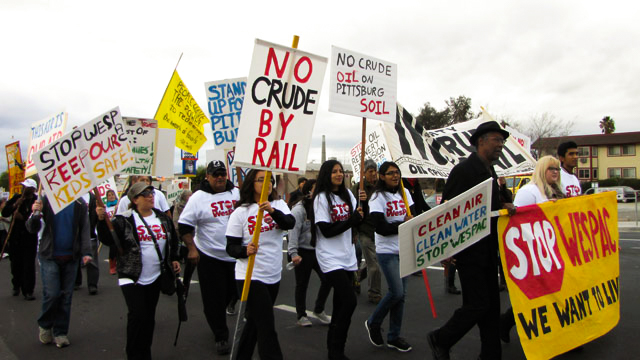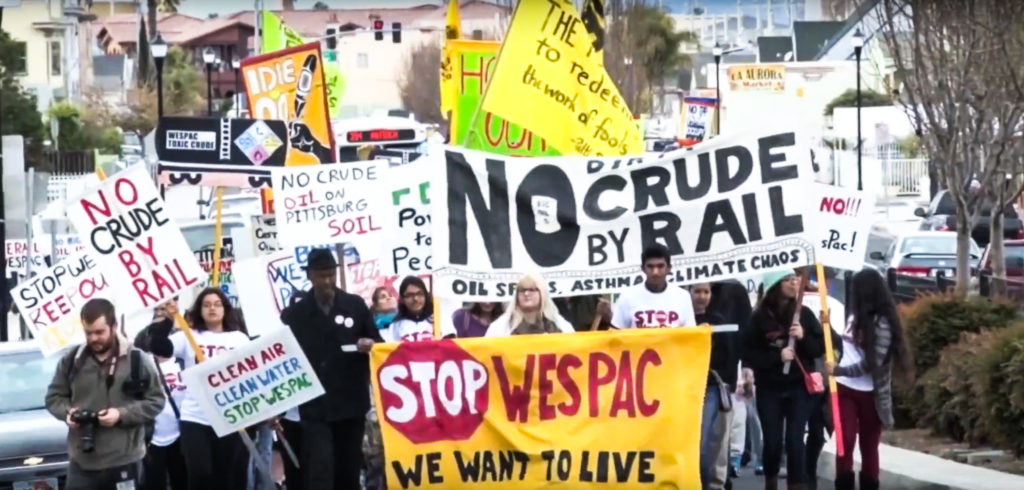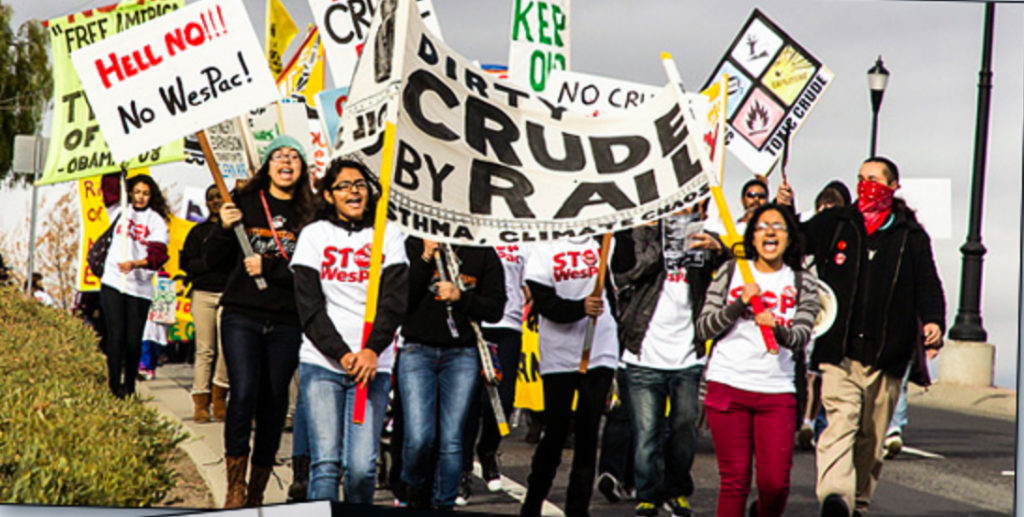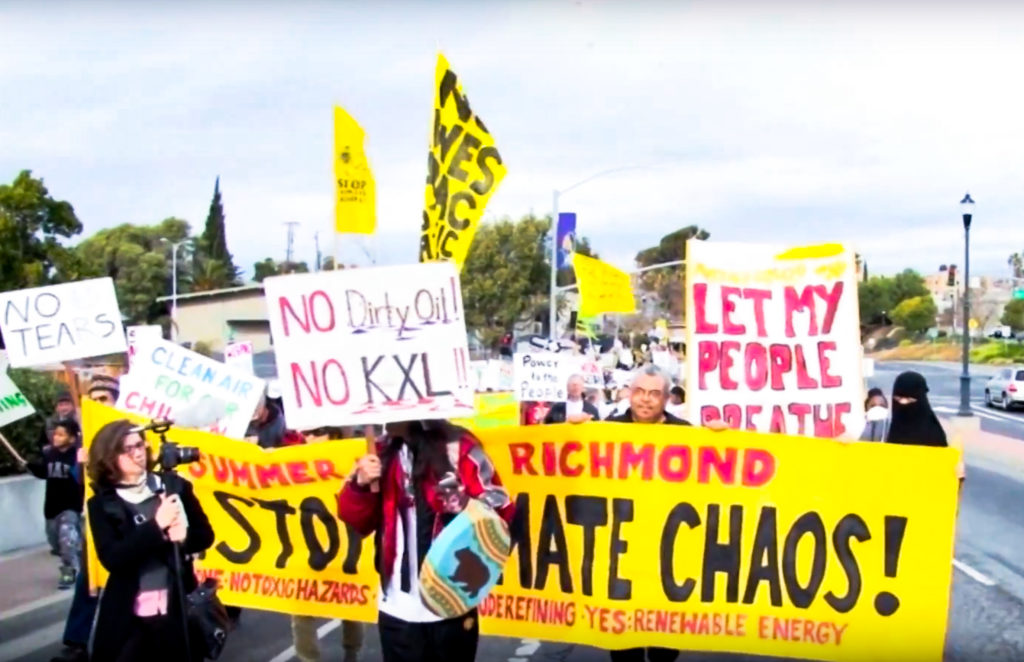Introduction
I quickly walk over to the building that houses Greg’s insurance agency, as well as other suites – I am running late. The downtown area brings back a flood of memories: running to the marina for cross country practice, eating at the New Mecca Cafe, and visiting the farmer’s market with my dad. But most importantly, and what brought me back today, was the memory of beginning our demonstration rally against WesPac, and the crude oil terminal they had proposed to build on our Delta a few blocks away.
The development of the downtown area, Old Town Pittsburg, California, was a recent endeavor, sparked by the city to reinvigorate the community’s local businesses, culture, and arts. Pittsburg has long had a rich history with the performing arts; the Creative Arts Building has hosted Louis Armstrong, Ray Charles, Stevie Wonder, and countless other performers. The Pittsburg High School Marching Band has been recognized at the international level. The community is also quite diverse, with a majority of the population identifying as Hispanic or Latino, Asian, Black, or African American. With such rich cultural diversity, it’s only natural that one of the largest events put on by the high school is an annual multicultural assembly, where students celebrate their cultural identities through a dance performance.
Nonetheless, the city is not without its own issues. It often serves as a battleground for many different “isms.” There is a wealth of cultural vitality in Pittsburg, yet I, a Punjabi woman of color, still experience racism from other black and brown people. The city also suffers from an income inequality higher than the national average. The average age is increasing in the city, as young people are leaving and not returning. The primary industries are health care and social assistance, and retail trade. The highest paying jobs are tied to utilities, mining, and oil and gas extraction. A young person seeking work in a professional, scientific, or technical role is most likely to find that job within the heavy industries, like Dow Chemical and Praxair. For those seeking employment in other sectors, Pittsburg is unlikely to provide them opportunities.
I arrive at the address Greg sent me. After a few unsure knocks, I enter the building and find my way upstairs where his office is located. Our paths first crossed in 2013 when the community of Pittsburg began rallying against WesPac. The WesPac project mobilized Pittsburg residents in a way that no other issue had, and it was successful in defeating a huge corporation which sought to bring dirty oil into our already-polluted community. At that time, Greg had become a strong supporter of young people organizing against the crude oil project.
While Greg Osorio’s day job is as an insurance agent, he spends most of his time embodying his social justice values. He invests his time and energy into working with folks at the social justice non-profit he helped co-found, called Souljah’s. Souljah’s is dedicated to “helping oppressed people everywhere.” Greg is also deeply involved in the Pittsburg community as a continued supporter and organizer of annual Cesar Chavez and Martin Luther King, Jr. Day events. I remember when I was in high school and Dolores Huerta came to speak at our Cesar Chavez assembly. Greg made sure to take me backstage to meet her personally.
As I walk into his office, he greets me with the same smile I remember. We sit down and our conversation picks up naturally as I speak about my Environmental Justice course. I bring up the WesPac protests, and I tell Greg that I am interested in hearing his timeline of the entire movement. I was 16 at the time of the organizing efforts and do not remember all of the details and logistics; I had mostly worked on the youth mobilization front. From what I understood, there were various organizations and leaders working on this movement, yet it was still a united front. Greg, however, reveals that it was far more complicated than that.

~
In 2012, WesPac, an energy infrastructure company, proposed building a crude oil terminal in Pittsburg, California. In the wake of the proposal, two grassroots community groups formed to combat the threat in an otherwise politically disengaged community. The Pittsburg Defense Council (PDC), and the Pittsburg Ethics Council (PEC) worked tirelessly to prevent WesPac from taking over our already-overwhelmed industrial suburb. Over the course of two and a half years, the two groups worked hard to convince the city council to reject the project. They came together a few times, but mostly worked individually on different fronts. Their efforts drew the attention of local advocacy groups such as the Sunflower Alliance, Communities for a Better Environment, Sierra Club, NRDC, and more. Local news outlets highlighted the citizen movement taking place in the East Bay town.
Now, years later, I was learning from Greg about the tensions between the two groups. Despite being in the midst of the movement and operating in both spaces, I had failed to see the strain between the PDC, and the PEC. In retrospect, the differences in their strategies were quite obvious. PEC was ferocious in calling out WesPac and city council, mobilizing the youth of Pittsburg, and engaging working-class people of color. PDC used more calmer rhetoric, and employed a regularly updated website, mailing list, and strong media presence. Despite their clashes, the presence of the two organizations was vital to the WesPac movement as a whole, because both strategies were rooted in different philosophies and, therefore, reached different people. This made for a diverse mobilization. The combination of a reformist PDC and a revolutionary PEC were what made success possible in Pittsburg.

Timeline and Points of Contention
The WesPac project was proposed in July 2012 but received public attention in July 2013 when the Recirculated Draft Environmental Impact Report (RDEIR), compiled by WesPac, was made available to the public. The 125-acre terminal project consisted of a marine terminal and storage facility, as well as a rail transload facility and pipeline. The average throughput of crude oil or partially refined crude oil per day was estimated to be 242,000 barrels—about four times the daily flow rate of the burst well in the BP oil spill The RDEIR acknowledged that the project posed significant and unavoidable risks: the introduction or spread of aquatic invasive species, reduced air quality, release of a hazardous material to the environment, and more.
As a 16-year-old, I was uninterested in protest or organizing efforts; I was too preoccupied by the four AP classes I was taking. I spent a lot of time with my AP Physics teacher, Ms. Fitz, getting much-needed help on our weekly problem sets. I usually came by after Cross-Country practice, which meant that office hours did not end until 6 or 7 at night. I remember one day asking her if she was finally going home, since she lived far, but she said no. She was on her way to a local meeting against a crude oil terminal. I definitely shrugged it off that first time, too distracted with homework, but after a week or so I finally asked her what crude oil was and why she cared so much. She sat down and explained to me what this project meant for a community like Pittsburg. She offered to take me along to the next PDC meeting. Although it would be late in the evening, I decided to go.
That evening, I was welcomed in a room full of concerned citizens, local advocates and community organizers. We learned the hard facts about the project and strategized counter-efforts in small groups. I was in awe of the fact that my voice was not only listened to but encouraged; I was chosen to share out my breakout group’s discussion with the larger collective. In that moment, I felt the power in my voice, and deconstructed the dichotomy I had created between myself and the “adults with knowledge.” I had recently started a community service club with my friend, Mohammed, and after that meeting, we decided to shift our club’s efforts onto the WesPac project. It was not long before the project spread beyond my friends and throughout our high school. Soon, we had organized our own carpools to meetings, circulated petitions amongst our peers, and held our own strategizing and information-gathering sessions.
Along with petitioning, there was a lot of planning underway for a demonstration rally intended for early January 2014. The Monday before the rally, there was a city council meeting. With my teacher’s encouragement, my friends and I prepared short comments. I spent a while figuring out what I would say and decided to focus on the city’s mission statement, highlighting how the city council was going against its own established values by supporting WesPac.
At that city council meeting, there were quite a few people present to speak out against WesPac. The new mayor was also being inaugurated at this meeting, so turnout was high. After a few older white folks spoke about the pollution and noise issues surrounding the project, a man in a leather jacket and a baseball hat went up. His voice was sharp and demanding, and immediately he stood out from the other speakers. This was George Monterrey. He said he wasn’t here to ask anymore, but to tell city council that no one wanted this project. He went on to say, “the city is not your fiefdom, we don’t work for you, you work for us… we will hold you morally responsible if anything happens to our city…WesPac…hell no!”
George and Lyana Monterrey were credited as the couple who first spread news about the project and founded the PDC. They were both born to Nicaraguan families and raised in the Mission District in San Francisco, and they had resided in Pittsburg for 30 years. George was a Golden Gloves boxer, Vietnam War veteran, and worked a number of jobs in industry. Lyana had always been in the financial sector.
When Lyana Monterrey had learned about the WesPac project, she immediately began knocking on her neighbors’ doors. The site of the proposed crude oil terminal was only blocks away from her home, and she had recognized the risks crude oil posed. Her neighbors, Kalli and Lisa Graham, also joined in on the fight. Once word got out, concerned citizens began to circulate written petitions against the project to show the community’s opposition. The Pittsburg Defense Council had been born out of these efforts as a self-identifying grassroots group fighting the proposed crude oil terminal. However, the Monterreys had eventually left PDC when they realized they didn’t fully agree with Lisa and Kalli Graham who went on to take over the organization. George and Lyana Monterrey were ferocious in their organizing, and their constructive anger often guided their dialogue and how they framed their views.
After the city council meeting, members of the PDC went up to congratulate the new mayor and thank the previous one, in an effort to maintain a positive relationship with the city council. The Grahams took on a calm and collected approach when engaging with city council. PDC saw the council members as people they knew, and as fellow residents. They built personal connections with council members and helped them recognize the harms that this project posed. PDC believed that the council was simply uninformed and that by engaging in dialogue with one another, the council would soon realize the flaws in their thinking.
But I was in awe of George’s ability to question the council and remind them that they were elected to serve the people of Pittsburg. His approach resonated the most with me as a person of color from the community, who saw the council as not listening to its own residents. The Monterreys and PEC did not believe that they could negotiate with city council. PEC felt as though the city had made up its mind and was guided by money and votes, and not the voices of the people. They did not think it made sense for residents to have to negotiate for clean air, clean water, and healthy lives.
The following Saturday at Mariner Park, at the start of the demonstration rally, George and his wife, Lyana, spotted me and my friends. They called us over towards their truck. George introduced himself as part of the Pittsburg Ethics Council. The PEC consisted of the Monterreys and Greg Osorio, as well as members of the community who did not mirror the same approach as the Grahams and other folks in the PDC. Where the PDC was more strategic in working with city council, the PEC was more insistent on challenging city council and engaging the working-class people of color.
George joked around with me by saying my speech at city council was the best out of everyone, aside from, of course, himself. He even asked me to be his campaign manager when he decided to run for city council and asked that I sit on PEC’s board. George and Lyana’s easy-going personalities, openness, and strong encouragement felt warm and welcoming. They differed from the environment of PDC meetings, which were buzzing with activity that provided a great space for mingling and strategizing, but not for heart-to-heart conversations. George and Lyana were also very committed to mobilizing young people who would then go on to challenge the system and reimagine it.
Because we felt more heard in the PEC, us youth slowly started to drift there, away from the PDC. The Monterreys and Greg Osorio guided us through our efforts to educate ourselves and our peers. As young people from the community who had come to question authority, our anger was directed at city council. We decided that we were informed enough about WesPac to take a stance, but many of our peers were not. So, we created a PowerPoint with information about the project and current organizing efforts and visited classrooms to do a 10-minute talk. We did not conclude by telling everyone to join our stance against WesPac – instead, we advocated that our peers wake up and pay attention to what was going on around them so that they can be informed citizens. Without the involvement of active, informed citizens, the city council could continue to make harmful decisions and face zero repercussions. The Monterreys and Greg were heavily invested in stopping WesPac, but they were also keen on supporting us to be a generation of conscious individuals.
Over the course of two and a half years, the WesPac project was challenged by significant citizen uproar. WesPac and the city council had originally believed that the project would be quietly approved, but with the help of the PEC and PDC, the people of Pittsburg made their voices heard. After months of highlighting the dangers of rail transport, WesPac was forced to adjust their plan to instead bring in crude oil by ship only. This adjustment required the company to write another Environmental Impact Report. At this time, oil prices had dropped nationally, and the demand for US-based oil was declining. The local organizing efforts of PEC and PDC were able to forestall the project long enough to make it unfeasible and too expensive to move forward. At the end of 2015, WesPac withdrew their Pittsburg oil terminal project due to “business reasons.” We, however, know that they were tired of having to clash against a community that was tactically equipped to challenge them at every step.

Reformist // Revolutionary
In essence, I believe that the Pittsburg Ethics Council embodied a revolutionary framework, while the Pittsburg Defense Council embodied a reformist framework. PEC was a reactionary space that existed only when the potential harm of the WesPac project charged the fire and anger of young people and residents. They worked on systemic change, starting with the very type of dialogues people hold; theirs was a revolutionary approach to changing the system.
PDC, on the other hand, built ties with the council, and today its remaining board of 3-4 members still advises on occasional council projects. PDC’s reformist approach has been fairly successful at working with the city council, which has led to changes within the system. Both groups are in it for the long run. While PEC eventually disbanded, the Monterreys and Greg continue to invest time and energy into the community, and they also did so before WesPac came. George coaches community baseball teams for kids and ran for city council. Greg continues to be a long-time organizer of annual community events.
But it was the combination of the two groups, reformist PDC and revolutionary PEC, that made this movement successful in Pittsburg. The two groups attracted different sets of people: older residents, young people, environmental organizers, and concerned parents. In the case of the demonstration rally, PEC was able to bring in people who would not have been in the City Hall space. It attracted speakers who were predominantly residents and people of color, and who shaped their outcry against the health risks this project posed to their children’s lives and the health of all people. PEC was able to mobilize young people to see the power in their voice and without that encouragement, I would not be at Stanford, nor would I be writing this piece.
But it was PDC’s website that made it very easy for outside organizations to get in contact with community organizers. They helped to involve the press, who shared a number of stories from the movement. The media coverage drew the attention of then California State Attorney General, Kamala Harris, who wrote an 11-page letter criticizing the WesPac project’s Environmental Impact Report.
Had the WesPac movement been entirely reformist or entirely revolutionary, people would have been excluded. Pittsburg is an extremely diverse community, so multiple angles were needed to connect with people’s varying needs. Some people cared about their homes, while others cared about the future, and many were cognizant of past injustices. The collision of each organization’s methods brought all of those people together and resulted in a huge and rare community success. Despite that success, the movement was not without its own internal struggles. Homophobia, racism, and sexism were very much a part of the two spaces, and it is important to learn from these failures in addition to the movement’s success.

Future Directions
As the city continues to develop and situate itself in the larger context of climate change, we must begin imagining a just transition for Pittsburg. This transition can be achieved through a variety of strategies, beyond just reformist or revolutionary. Just as the WesPac movement balanced the two strategies and drew in a huge crowd, there is potential for a sustainable community space to exist where community members from all walks of life can share their concerns and hopes for the future of the community. In doing so, perhaps we can model a future for Pittsburg that does not rely on fossil fuels, but that prioritizes the needs of its people, that provides good quality of life, that embodies kindness towards one another, and that uplifts the voices of young people.
Reporting was aided by personal and phone interviews, with special thanks to Kalli Graham, Susan Burkitt, George and Lyana Monterrey, Greg Osorio, and M. MacKerel.